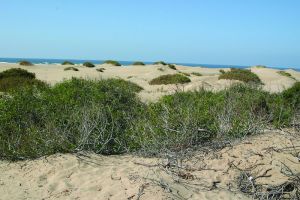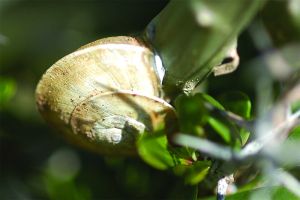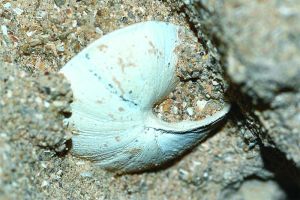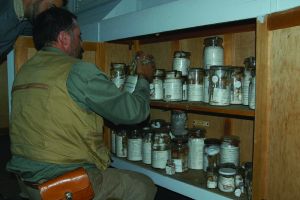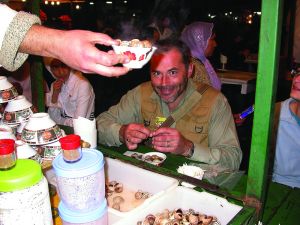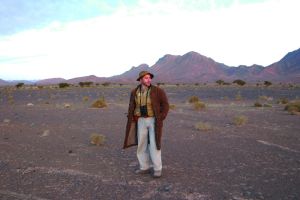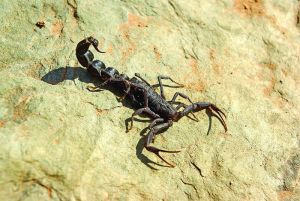|
In November 2008 I formed a part of a team that carried out biological work in Morocco. This was the last fieldwork trip carried out as a part of the GIBMANTUR campaign, an Interreg IIIA Gibraltar-Morocco project run by the Gibraltar Ornithological & Natural History Society and the Institut Scientifique of the University Mohammed V Rabat-Agdal, co-funded by the European Union and the Government of Gibraltar. During the two week trip I collected at 63 locations and amassed a very large amount of material, both live and dead. Morocco is a very interesting place for the malacologist. It lies in the West Mediterranean and West Saharo-Arabian biogeographical regions and has high species diversity and high rates of endemism. Morocco has a complex geology with four main physiographic regions:
The climate is generally Mediterranean-subtropical with cooling Atlantic and Mediterranean breezes. There is considerable fluctuation in the interior with cold winters and hot summers. Temperatures may drop below zero in the Atlas Mountains with snow on mountain peaks during most of the year. The south and southeast desert regions become very hot during the summer. Morocco is of great interest biogeographically and ecologically because of its key location between the rest of the African continent and Europe. There are many floral and faunal similarities between southern Iberia and the Mahgreb region, which includes Morocco. Some species have relict distributions as a result of the previous continuity of the Betics-Rif mountain chain running from southern Iberia to North Africa, and subsequent vicariance events. Existing evidence for this continuity has recently been substantiated by plate reconstructions that indicate late Cretaceous-Palaeogene congruence between African and European plates. During the Tertiary the western Mediterranean was involved in a series of events caused by the interactions of the African and European Plates. The eastern movement of the African Plate during the Oligocene or Lower Miocene caused detachment of the western portion of the Alpidic Chain and its fragmentation into a series of micro-plates which subsequently moved in various directions in the Mediterranean, some towards North Africa, the Kabylias (Algeria), Italy (Calabro- Peloritan), Corisca and Sardinia. The Strait of Gibraltar separates the Iberian fauna from the Mahgreb and has been a geographic barrier for gene flow during the last 5 million years. The Miocene desiccation of the Mediterranean Basin (the Messinian Salinity Crisis) resulted from the closing of the Strait 5.96 million years ago creating land bridges which may have allowed exchange between the Iberian and Mahgrebian faunas. There is evidence that these geological changes may have led to vicariance and subsequent genetic differentiation. There is a lot of opportunity for new work for the malacologist. A revision of many of the molluscan taxa is required to accurately assess diversity and systematic status. Many problematic taxa exist and there is much synonymy in the early literature. Most of the published literature on the land mollusca of Morocco dates back from the 1870s to 1930s. During the 1980s Mary Seddon and colleagues, from the National Museum of Wales, undertook mapping work in Morocco (as well as Algeria and Tunisia) and several papers were published, mostly on taxonomic and distributional aspects of their research. Very few papers have been published on the Moroccan land molluscs in the last 10-15 years, and no biogeographical treatment exists. Our fieldwork trip took in the three Atlas ranges, south and south-western Morocco as well as parts of the west coast. I collected enough material to keep any malacologist sorting, identifying, synthesising and studying for years! Some of it may represent new species as well as material rarely collected live before. I collected a lot of Theba including the polytypic T. subdentata (Férussac, 1821). Live material of T. pisana ampullacea (Pallary, 1915) was collected at Souss-Massa and T. subdentata helicella (Wood, 1828) was recorded from several localities including Cap Ghir and Essaouira. At Cap Ghir the subspecies occurs sympatrically with T. subdentata dehnei (Rossmässler, 1846), both present in high abundance as death assemblages although live material was scarce. Live T. subdentata helicella were found attached to Euphorbia spp. Fossil T. subdentata helicella, and other helicid, material was found 5km north from Cap Ghir in consolidated sand deposits (these require dating to verify age). The live material collected from this trip, all preserved in ethanol, will help solve a ‘Theba mystery’. This is the highly disjunct distribution of T. subdentata helicella. The species has been recorded from coastal areas in west Morocco, from Tensift (about 30 km south of Safi) south to Cap Ghir, and from Almeria, southeast Spain. Material in the former Altimira collection from El Alquián in Almeria prompted Gittenberger and Ripken to search for live material. They did not find the species and concluded it may once have been introduced into southern Spain, but had since become extinct. During recent fieldwork at Retamar, Almeria, however, I found the species at low abundance. Further fieldwork at El Alquián, Almeria, led to my finding the species at densities of up to about 50/m2. The re-discovery of this species at high density adds to the records of Puente et al. and Moreno and Ramos. The material from Cap Ghir and from El Alquián will be used to study genetic similarities between these populations to assess degree of relatedness, probable timing of divergence event(s) and evolutionary outcomes, and so provide a better understanding of the species’ distribution. Other genera collected include: Rumina, Cochlicella, Otala, Pseudotachea, Sphincterochila, Tingitana, Trochoidea, Xeroleuca, Hygromia and Helicopsis. I have been able to identify some of the material; some species occurring in southern Iberia also, an area I have worked for many years. A lot of it, though, will be challenging and I plan to take advantage of Mary Seddon’s offer to use the Cardiff collections for comparisons. I also spent a little time looking at the collections in the Mohammed V Rabat-Agdal University and I plan to return there to do more detailed work. The collections have not been studied for many years and there’s a possibility that some of the original Pallary material may be there. Another part of my malacological activities included eating some of my research subjects! Whilst in Marrakech I sampled the excellent cooked snails offered by the vendors in the main marketplace. The snails are prepared in a lighter sauce than commonly available in southern Spain, although the Moroccan sauce is slightly more spicy. I asked several of the vendors where they sourced their snails, but they were guarded as to revealing localities. Even though one of the vendors told me these were collected locally, the large numbers sold, however, could not, I think, be sustained from wild populations. Morocco is one of the world’s largest exporters of snails, and a significant number are exported to southern Spain to keep the snail-hungry Spaniards in supply. I suspect, therefore, that heliculture is keeping the vendors in Marrakech in business. But this is yet another Moroccan malacological question that requires further research to answer! Selected Bibliography Alvarez A. 1976. A former continuation of the Alps. Geological Society of America Bulletin 87: 891-896. Aparicio MT, Seddon MB, Holyoak DT. 199. Systematics and distribution of Helicopsis (Xeroleuca) in Morocco (Mollusca, Gastropoda: Helicidae). Journal of Conchology 34: 47-58. Arrebola Burgos JR, Gittenberger. 1993. New distributional data for Rupestrella dupotetii (Terver) (Gastropoda: Chondrinidae) from southern Spain and NW. Africa, with notes on allegedly subspecific characters. Journal of Conchology 34: 351-355. Blondel J, Aronson J. 1999. Biology and Wildlife of the Mediterranean Region. Oxford: Oxford University Press. Bernardos S, Amich F, Gallego F. 2003. Karyological and taxonomic notes on Ophrys (Orchidoideae, Orchidaceae) from the Iberian Peninsula. Botanical Journal of the Linnean Society 142: 395-406. Buckhard M, Critg S, Helg U, Robert-Chorrue C, Soulaimani A. 2006. Tectonics of the Anti-Atlas of Morocco. Comptes Rendus Geosciences 338: 11-24. Busack SD. 1986. Biogeographic analysis of the herpetofauna separated by the formation of the Strait of Gibraltar. National Geographic Research 2: 17-36. Carbonell R, Sallarés V, Pous J, Dañobeitia JJ, Queralt P, Kedo JJ, García Dueñas V. 1998. A multidisciplinary geophysical study in the Betic Chain (southern Iberia Peninsula). Tectonophysics 288: 137-152. Castella V, Ruedi M, Excoffier L, Ibanez C, Arlettaz R, Hauser J. 2000. Is the Gibraltar Strait a barrier to gene flow for the bat Myostis myotis (Chiroptera: Vespertilionidae)? Molecular Ecology 9: 1761-1772. Chbouki N, Stockton CW, Myers DE. 1995. Spatio-temporal patterns of drought in Morocco. International Journal of Climatology 15: 187-205. Davis WM. 1920. The Physical Geography of West-Central Morocco. Geographical Review 10: 53. De Jong H. 1988. In search of historical biogeographic patterns in the Mediterranean terrestrial fauna. Biological Journal of the Linnean Society 65: 99-164. Diabaté L, Blanc P, Wald L. 2004. Solar radiation climate in Africa. Solar Energy 76: 733-744. Gantenbein B. 2004. The genetic population structure of Buthus occitanus (Scorpiones: Buthidae) across the Strait of Gibraltar: calibrating a molecular clock using nuclear allozyme variation. Biological Journal of the Linnean Society 81: 519-534. Gantenbein B, Largiadèr CR. 2003. The phylogeographic importance of the Strait of Gibraltar as a gene flow barrier in terrestrial arthropods: a case study with the scorpion Buthus occitanus as a model organism. Molecular Phylogenetics and Evolution 28: 119-130. Gittenberger E, Ripken ThEJ. 1987. The genus Theba (Mollusca: Gastropoda: Helicidae), systematics and distribution. Zoologische Verhandelingen 241: 1-60. Giusti F, Manganelli G. 1984. Relationships between geological land evolution and present distribution of terrestrial gastropods in the western Mediterranean area. In: Solem A, Bruggen AC Van, eds. World-Wide Snails. Biogeographical studies on non-marine Mollusca. Leiden: Brill/Backhuys, 70-92. Gómez-Zurita J, Juan C, Petitpierre E. 2000. The evolutionary history of the genus Timarcha (Coleoptera, Chrysomelidae) inferred from mitochondrial COII gene and partial 16S rDNA sequences. Molecular Phylogenetics and Evolution 14: 304-317. Guiller A, Madec L, Daguzan J. 1994. Geographical patterns of genetic differentiation in the landsnail Helix aspersa Müller (Gastropoda:Pulmonata). Journal of Molluscan Studies 60: 205-221. Hirano J. 1991. Kingdom of Morocco and its agriculture. Geography 46: 565-569. Holyoak DT, Seddon MB. 1993. Further notes on the Aciculidae (Gastropoda: Prosobranchia) of NW. Africa. Journal of Conchology 34: 357-363. Hrbek T, Meyer A. 2003. Closing of the Tethys Sea and the phylogeny of Eurasian killifishes (Cyprinodontiformes: Cyprinodontidae). Journal of Evolutionary Biology 16: 17-36. Hsu KJ. 1972. Origin of saline giants: a critical review after the discovery of the Mediterranean evaporate. Earth Science Review 8: 371-396. Hsu KJ, Montadert L, Bernoulli D, Cita MB, Erickson A, Garrison RE, Kidd RB, Mèlierés F, Müller C, Wright R. 1977. History of the Mediterranean salinity crisis. Nature 267: 399-403. Lledó MD, Erben M, Crespo MB. 2003. Myriolepsis, a new genus segregated from Limonium (Plumbaginaceae). Taxon 52: 67-73. Martínez-Martínez JM, Booth-Rea G, Azañón JM, Torcal F. 2006. Active transfer fault zone linking a segmented extensional system (Betics, southern Spain): Insight into heterogeneous extension driven by edge delamination. Tectonophysics 422: 159- 173 Menez A. 2006. Theba subdentata helicella (Wood, 1828) from southern Spain. Tentacle 14: 6-7. Molero-Baltanás R, Gaju-Ricart M, Bach de Roca C. 2002. Myrmecophilic Zygentoma (Insecta: Apterygota) from the iberobalearic fauna. Biogeographic remarks: Proceedings of the Xth international Colloquium on Apterygota, České Budějovice 2000: Apterygota at the Beginning of the Third Millennium. Pedobiologia 46: 284-295. Moreno D, Ramos MA. 2000. Recent data on the distribution of Theba subdentata helicella (Wood, 1828) (Gastropoda, Helicidae) in Almería (Spain). Absatracts, I Congresso Congiunto delle Societá Malacologiche del Mediterraneo, Genoa. Moreno D, Ramos MA. 2007. New data on Theba subdentata helicella (Wood, 1828) (Gastropoda, Helicidae) in Almería (SE Spain). Iberus 25: 89-113. Mousson A. 1874. Bemerkungen über die von Hrn. Dr. von Fritsch und Dr. Rein aus West-Marokko 1872 zurueckgebrachten Land-und Susswasser-Mollusken. Jahrbuch der Deutschen Malakozoologischen Gesellschaft 1: 1-16, 81-107. Norris A. 1986. Distributional records of land Mollusca from southern Morocco. Journal of Conchology 32: 259-260. Pallary P. 1898. Deuxieme contribution a l’etude de la Faune malacologique du Nord-Ouest de l’Afrique. Supplement a ‘La Faune malacologique du Maroc de A. Morelet’. Journal de Conchyliologie 46: 49-170. Pallary P. 1904. Quatrieme contribution a l’etude de la Faune malacologique du nord-ouest de l’Afrique. (Deuxieme supplement a la ‘Faune malacologique du Maroc’ d’Arthur Morelet). Journal de Conchyliologie 52: 5-58. Pallary P. 1921. Faune malacologique du Gran Atlas. Journal de Conchyliologie 66: 89-154. Pallary P. 1936. Deuxieme complement a la Faune malacologique de la Berberie. Journal de Conchyliologie 80: 5-65. Palmer M, Cambefort I. 2000. Evidence for reticulate paleogeography: beetle diversity linked to connection-disjunction cycles of the Gibraltar strait. Journal of Biogeography 27: 403-416. Piqué A. 2001. Geology of Northwest Africa. Beiträge zur regionalen Geologie de Erde, 29. Verlag: Stuttgart. Puente AI, Altonaga K, Unamuno E, Prieto E. 1994. Sobre la presencia de Theba subdentata helicella (Wood, 1828) en el sur de Almería. Libro de Resúmenes del X Congreso Nacional de Malacológia. Barcelona, 91-92. Rosenbaum G, Lister GS, Duboz C. 2002. Relative motions of Africa, Iberia and Europe during Alpine orogeny. Tectonophysics 359: 117-129. Rosenbaum G, Lister GS. 2004. Formation of arcuate orogenic belts in the western Mediterranean region. Geological Society of America Special Paper 383, 41-56. Rosenbaum G, Lister GS. 2005. The Western Alps from the Jurassic to Oligocene: spatio-temporal constraints and evolutionary reconstructions. Earth-Science Reviews 69: 281-306 Schettino A, Turco E. 2006. Plate kinematics of the Western Mediterranean region during the Oligocene and Early Miocene. Geophysical Journal International 166: 1398-1423. Seddon MB. 1992. The distribution of Pupoides coenopictus (Hutton, 1834) in NW. Africa (Gastropoda: Pupillidae). Journal of Conchology 34: 149-158. Seddon MB, Holyoak DT, Tattersfield P. 1993. Taxonomy, ecology and distribution of Leiostyla in W. Europe and NW. Africa (Gastropoda: Pupillidae). Journal of Conchology 34: 311-320. Seddon MB, Aparicio MT, Holyoak DT. 1994. Taxonomy of five species of Helicopsis (Helicopsis) from Morocco (Gastropoda: Helicoidea). Journal of Conchology 35: 45-66. Seddon MB, Aparicio MT. 1998. Problematic taxa from Moroccothe status of ‘Helix argonautula’ Webb & Berthelot, 1833, ‘Helix renati’ Dautzenberg, 1894 and Xeroleuca antoinei Pallary, 1936. Journal of Conchology 36: 19-29. Smethurst D. 2000. Mountain Geography. Geological Review 90: 35-56. |
Figure 1 Souss Massa, where live Theba pisana ampullacea (Pallary, 1915) were found on vegetation. (photo: A. Menez/GONHS).
Figure 2 Theba subdentata helicella (Wood, 1828) on Euphorbia sp. at Cap Ghir. (photo: A. Menez/GONHS).
Figure 3 Fossil Theba subdentata helicella (Wood, 1828) from deposits 5km north of Cap Ghir. (photo: A. Menez/GONHS).
Figure 4 A part of the collections in the Mohammed V Rabat-Agdal University, Rabat. (photo: L. Linares/GONHS).
Figure 5 The author, ready for fieldwork on the plains of M’Cissi. (photo: L. Linares/GONHS).
Figure 6 All a part of serious malacological research: the author tucking into juicy helicids in the main market at Marrakech (photo: I. Thompson/GONHS).
Figure 7 You need to take a little extra care in Morocco when looking for snails under stones. A large black scorpion in Sidi Quasik. (photo: L. Linares/GONHS).
Figure 8 Not everything you find with a shell in Morocco is a snail! This tortoise was photographed at Tiznit, but they were present at several of the sites visited (photo: A. Menez/GONHS).
Figure 9 An example of one of the many wonderful areas sampled: Euphorbia-Argania habitat in Tighmi. (photo: A. Menez/GONHS). |

